The Duranta is a sprawling large shrub to around 3 or 4 metres with cane-like growth, and is fast growing. It has many common names, but we'll just call it Duranta. The flowers are on short stems, and are prolific if the plant is in full sun, and gets the right amount of water and fertilizer. The flowers are variations of mainly Blue colour. The leaves and berries are poisonous to humans, but a lot of birds like to eat them, Hummingbirds included, as well as butterflies. It is easily propagated by cuttings, and has a reputation for being invasive in some countries. Grow this plant in all but the coldest areas. The photos are from a local Sydney area.
***** Remember, to maximise your chances of Awards, keep your comments to 200 words max. and 5 photos/pics. Thankyou to all who have made this a really nice blog for the gardening enthusiast. *****
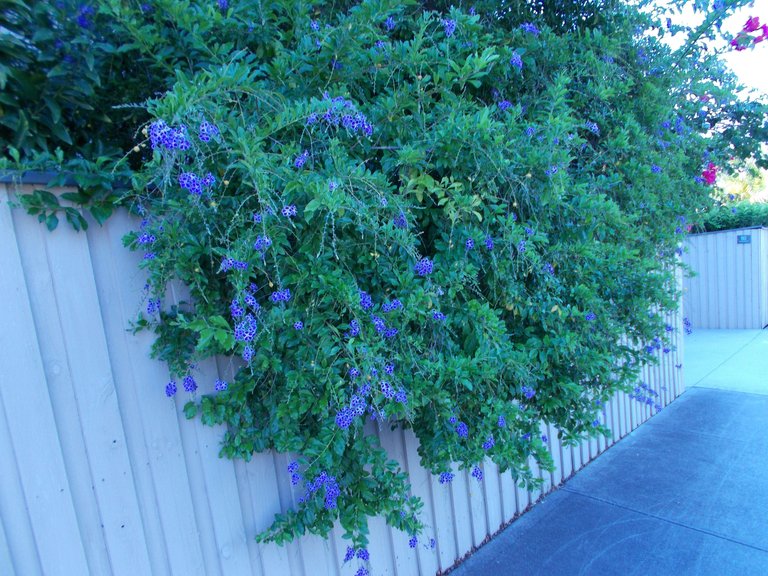
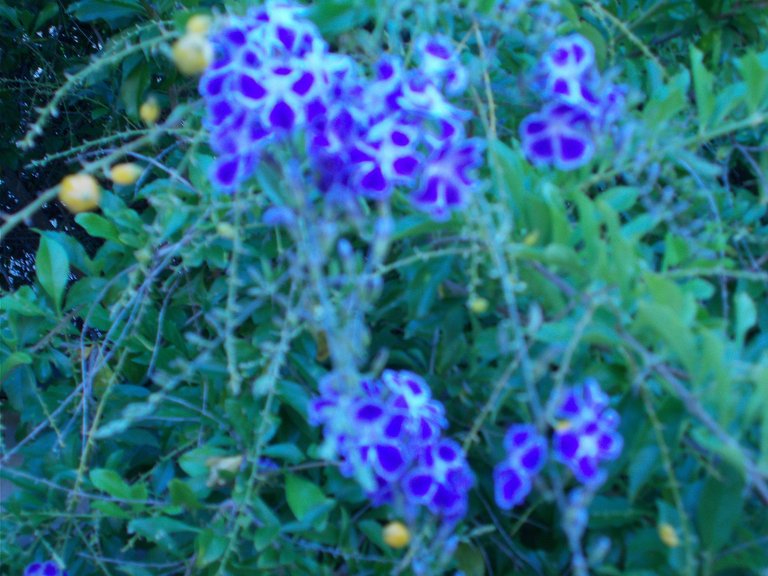
Duranta, usually a large, fast-growing, multi-stemmed shrub, has several common names and over 17 varieties worldwide.
The branches are often droopy and vinelike, and the stems may have sharp spines. Other common names are Pigeon-berry and Honey drops.
Typically, there are full clusters of fragrant pale-blue lavenders, purple or even white flowers on the ends of the stems, reminding the viewer of wisteria.
Butterflies and hummingbirds love them. Flowers are quickly followed by bunches of golden-orange berries, popular with birds.
Duranta loves full sun most, but tolerates part sun, or part shade.
source
Thanks @ctrl-alt-nwo for this colourful blog.
Congrats, you are sharing the Fav. comment Award with one other. Great Pics and info. Well done!
Thank you so much for kind appreciation. :)
The Duranta bush (Duranta erecta) — also known as pigeon berry, sky flower and golden dewdrop — is an easy-to-grow exotic plant native to tropical zones in the U.S. It lives for about 15 years, likes annual pruning of its dead branches and makes a good companion for impatiens.
The Duranta bush grows as an evergreen, rounded shrub or small tree in U.S. In colder climates, gardeners plant it as an annual in the garden or in containers. The Duranta bush grows quickly up to 15 feet high and wide as a shrub, but it tops out at about 5 feet tall when planted as an annual.
The Duranta bush’s fragrant lavender, purple or white flowers attract butterflies and hummingbirds to your landscape. The small flowers dangle from thorny, weeping branches with light gray bark among glossy, green, oval-shaped leaves.
The ideal spot for a Duranta bush is a moist place with full sun. This shrub attains its optimum size in any kind of well-drained soil with an acidic, neutral or slightly alkaline pH, as long as it’s rich in organic matter.
The Duranta bush resists disease but is susceptible to a variety of bugs, including scale insects, mealy bugs and nematodes. A scale insect infestation isn’t usually lethal, and you can control their populations by spraying the entire plant with horticultural oil in the dormant season.
** The leaves and berries of the duranta bush are poisonous**
Congrats, you are sharing the Fav. comment Award with one other. Great pics and info. Don't forget to quote your SOURCE next time, you don't want to copy others pics without crediting them !
Thank you so much @ctrl-alt-nwo for selecting my Reply's for The Fav. Comment Award.It means a lot to me.
Next time i surely mention the source.
Hi dear @ctrl-alt-nwo good to see you again with another amazing plant called the Duranta.
The genus, Duranata, honors an Italian botanist and papal physician named Castore Durantes. Durantes are subtropical plants and are grown as perennial shrubs in the southern-most parts of America.
They produce graceful, dropping branches, a few thorns, bright green leaves and numerous small blue, voilet, or white flowers which bloom best in full sun throughout the year followed by golden fruits.
Duranta does well in either acidic or alkaline soils and is somewhat resistant to disease and insect attack. It can be propagated by sowing the seed in the spring or from greenwood cuttings.
Duranta attracts birds which feed on the fruits and has one of the few flowers that attract both hummingbirds and butterflies. Many Duranta attarct bees also.
The berry is said to be toxic so keep away from pets and children.
Source 1
Source 2
Thank you for your precious time and support.
Duranta:
This rapidly growing shrub can get 10 to 15 feet tall and over 5 feet wide. It’s listed as hardy to only zone 9, so here in Central Texas, it dies to the ground in winter in most gardens.
Duranta is evergreen, hardly even skipping a bit in the coldest of winters.If Duranta dies to the ground in winter in your garden, simply prune it back to about 3 inches from the ground and it will reemerge from the roots in spring.
There are several cultivars of Duranta, but my favorite is the purple-flowering one. It flowers from early spring all the way through fall and doesn’t bat an eyelash at heat or the lack of rainfall.
If you want to attract native birds to your landscape, they’ll love the fruit of the white-flowering cultivar. Duranta will perform best in full sun, but can take light shade.
If you have blackberries and have harvested all of the fruit, tip-prune the canes back to about 4 feet to promote branching, and thus a heavier fruit crop next season.
@ctrl-alt-nwo, That would be better description indeed planting post. I'm most knowledge via your article and I add some content via internet. Winter hardy to USDA Zones 10-11 where plants are grown in moist, fertile, well-drained soils in full sun. Tolerates light shade, but best flowering is in full sun. Tolerates wide range of soils. Grow as an annual shrub, in containers or as a houseplant in the St. Louis area. Container plants must be brought inside in fall before first frost for overwintering in a bright sun room.
Duranta erecta, commonly called golden dewdrop, pigeon berry or sky flower, is native from Florida to Brazil and in the West Indies. It is a spreading, sometimes weeping, evergreen shrub or small tree that grows to 15-18’ tall in its native habitat. In St. Louis it is typically grown as a 2-4’ tall annual shrub or in containers that must be overwintered indoors. Sharp axillary thorns are usually present on stems of mature plants, but are usually absent on young plants. Features drooping axillary and terminal racemes of light blue to violet flowers which bloom summer to fall. Flowers give way in fall to drooping clusters of yellow-orange drupes (golden dewberries as it were). Fruit often does not appear on plants grown in the St. Louis area. Oval rounded light green leaves (to 2” long).
Source: http://www.missouribotanicalgarden.org/PlantFinder/PlantFinderDetails.aspx?kempercode=a507
Native to tropical areas of the Americas, Duranta (Duranta erecta) or pigeon berry is a frost-tender perennial. This 2- to 15-foot tall flowering shrub is well suited for border areas and living hedges. Clumps of blue, white or lavender colored flowers bloom throughout the growing season. The flowers provide visual interest year-round and attract butterflies and hummingbirds to the garden. Duranta is hardy in U.S. Department of Agriculture plant hardiness zones 10 through 11. In colder areas, grow it as an annual. Plant in full sun for best growth and development. Once planted, this flowering shrub requires only minimal maintenance.
Prune Duranta in late winter or early spring. Use a pair of sharp shears to remove any shoots that grow beyond the desired growing zone. Make cut horizontally across the branches. Wear gloves and protective eyewear to protect against the sharp thorns.
Durant. Due to its coloring, in the people it has received the name "heavenly flower". This is a durant, whose homeland is the South American continent. It also grows in Mexico, some species are found in India. The name of the plant was given by the famous naturalist Karl Linnaeus in honor of Castore Durante - an outstanding physician and botanist who lived in Italy in the 16th century. As you already wrote
leaves and fruits durants are poisonous, they can cause poisoning. When caring for the flower, you must be careful: wear gloves when pruning and wash hands thoroughly with warm water and soap after working with the plant. In a house where there are children, it is not recommended to grow durant, because beautiful flowers and attractive fruits can cause harm.
Thanks for the message, thanks to you I learn a lot about the plants :)
Another post about a very interesting plant Duranta.Duranta is a very nice looking shrub.

.jpg)

.jpg)
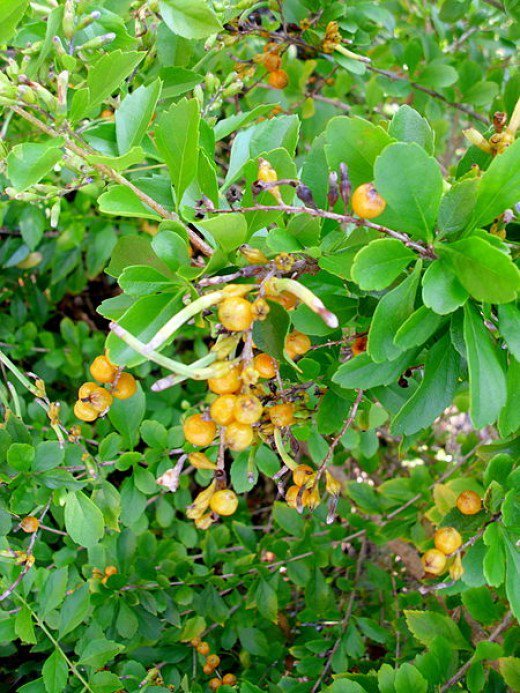
Botanical name: Duranta erecta, Duranta repens.
Duranta is also known as Golden Dewdrop, Pigeon Berry and Skyflower. Duranta is from the family Verbenaceae which is the verbena family and there are 17 different species. Duranta is native to the Americas and the Caribbean.Mature duranta have thorns and bloom light blue, violet or white coloured flowers.
Duranta have yellow or orange coloured berry fruit.
But The berries and leaves of duranta are poisonous, and have killed children, cats and dogs.
Naming of duranta:Duranta was named in honour of a 16th century Italian botanist and physician, Castor Durantes.
Butterflies and hummingbirds are attracted to duranta’s brightly coloured flowers.
Duranta is known as a weed in Australia, South Africa and China.
How to Grow Duranta:If you wanna grow duranta plant then you have to do the below things.
Duranta plants prefer rich organic soil that is somewhat loamy and drains well. It is especially important to keep soil light if you are planting in a container. Be sure that your container has plenty of drainage holes.
If planting in the ground, choose a location that receives full to part sun for best flowering display. Allow plenty of room for this tropical beauty to spread out.
Duranta is a very beautiful looking shrub and deadly also.parents and other adults should be careful about allowing children to come in contact with this plant because it is poisonous.
You should always handle the golden berry plant carefully since it has sharp edges and spines. The plant only causes problems when it is ingested.
Golden dewdrop contains saponins in the leaves and fruit that cause the following health problems:
Itchiness or allergic contact dermatitis
Vomiting
Convulsions
Nausea
Fever
Drowsiness
Stomach irritation
So we all should avoid getting in touch with this plant.
All the information is collected from google.Thanks for the post @ctrl-alt-nwo.
Duranta (Duranta erecta):
Alternative Name(s): Geisha Girl, Sheena's Gold.
Family: Verbenaceae.
Form: Shrub
Origin: Native to the Americas from Florida and Texas to Peru, Bolivia and Brazil.
Flowers/Seedhead: About 1.4 cm wide at the end of a tube 0.6–1 cm long. Inflorescence to 20 cm long. Flowers mostly late spring to autumn.
Description: Multistemmed shrub to 4 (rarely to 7) m high. Stems 4-angled when young. Leaves opposite or in whorls, 1–8 cm long, 0.5–3.5 cm wide, sparsely hairy to hairless, margins entire or coarsely toothed above the middle; leaf stalk 0.3–1 cm long. Fruit 5–10 mm wide, appears to be singleseeded but will break up into 4 (rarely 3) nutlets. Nutlets ellipsoid to ovoid, pale brown, 4–5 mm long.
Distinguishing features: Distinguished by branches that often have scattered to common spines on opposite sides of the stem; flowers in terminal and axillary racemes; petals purple, blue or white, united in a tube, two-lipped, one lip with 2 lobes and the other with 3 lobes; fruit ripening orange-yellow, with thin fleshy layer over tightly packed nutlets.
Dispersal: Spread by bat-dispersed and water-dispersed seed.
Notes: Grown as an ornamental and often used for hedging. Naturalised in tropical and subtropical areas. Competes with other vegetation. Leaves, fruit and bark are poisonous. First recorded as naturalised in Queensland in 1931. This species is also a problem in South Africa and Hawaii.
A fast-growing, small, evergreen shrub with bright yellow foliage. An ideal choice for low and clipped hedges/borders and provides great color contrast in large gardens.
Suitable for topiary and potted specimens and displays blue flowers in Summer followed by orange-colored berries. Prefers a fertile well-drained soil enriched with organic matter but will tolerate enriched sandy soils. Avoid heavy clay or poorly drained soils.
Grows well in tropical, subtropical and coastal conditions. Prefers regular watering but is drought tolerant once established. To maintain density and a good appearance, prune every 4-6 weeks and apply a slow release fertilizer at the beginning of Summer.
The lavender-blue or purple or white flowers appear in loose clusters, and both berries and blossoms are often seen on a plant. Flowers have a mild sweet vanilla-like smell.
Some Facts and Uses
The plant is used as an insect repellant
The plant is used in the treatment of fevers, skin itches
The plant is amenable to trimming and is often grown as a hedge. It is traditionally grown in living fences in the northwestern Himalayas, where it helps to exclude livestock and other animals; mark out land boundaries; whilst also providing a range of medicinal and other uses.
source
source
Duranta belongs to a magnificent, beautifully flowering shrub, which, rather, refers to exotic domestic species. Despite the luxurious appearance and unpretentiousness, now durant is rarely found in our houses, and you can see it only in the collections of enthusiastic flower growers and large greenhouses. But a few decades ago, the flower was widely distributed as a room culture. The situation must be corrected, the durant fully deserves more attention.
So, duranta (Latin Duranta) is a common name for the genus of perennial beautifully flowering bushes of the Verbenov family, which includes at least 22 species. Such a strange name this shrub received in honor of the Italian scientist Castore Durante, immortalized by Carl Linnaeus. The main value of duranta - beautiful flowers, consisting of five lobes of lilac, purple or white. There are also two-color colors - a white corolla and edges on a violet background. Flowers are collected in the inflorescence in the form of dense long brushes. After flowering, bright orange berries appear on the branches.
The leaves of the bush are no less beautiful: dense, saturated green with a smooth or serrated edge. There are also variegate (variegated) varieties of durants. Branches - dense, spreading, lignifying with age. Sometimes on the shoots there are sharp, hard thorns.
As a rule, duranta is cultivated in the form of spreading shrubs, but one of its species, duranta creeping (Latin Duranta repens) can be formed as a mini bonsai tree. In nature, pigeon berries are found in the tropics of South America, now the plant is grown in many southern regions as a decoration of the landscape.
http://wikibotanika.ru/komnatnie-rasteniya/ekzoticheskie/duranta.html
https://www.youtube.com/channel/UCTNOHeSpKQPMyWRrO9tqRsQ
Trees are the most beneficial for our environment. Trees are essential for maintaining the balance of the environment.
Duranta Flowering Plant Info;
The Duranta flowering plant (Duranta erecta) may reach up to 10 feet in height and flowers profusely from summer until the first heavy frost. The shrub-like plant is multi-stemmed and the branches are somewhat droopy. The stems may have sharp spines. Orchid-like flowers may be light blue to light purple in color. Some plants develop loads of yellow, ball-shaped drupes. Chemicals in the fruit may make them poisonous to humans but harmless to birds that enjoy them immensely.

How to Grow Duranta;
If you live in an area where Duranta plants are treated as annuals, a large container (such as a half whiskey barrel) is a fantastic place to grow the plant. When the weather becomes chilly, you can bring the plant inside and place it near a south-facing window for beautiful color all winter long. Duranta plants prefer rich organic soil that is somewhat loamy and drains well. It is especially important to keep soil light if you are planting in a container. Be sure that your container has plenty of drainage holes. If planting in the ground, choose a location that receives full to part sun for best flowering display. Allow plenty of room for this tropical beauty to spread out.
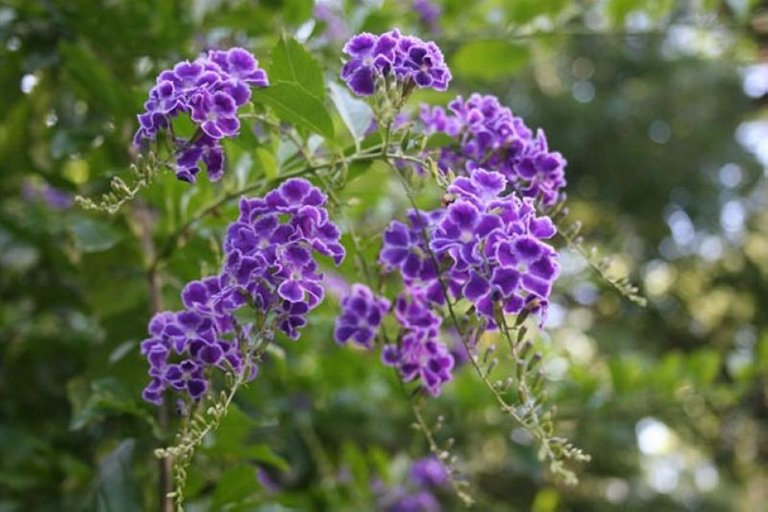
Care of Duranta Plants ;
Slow -fertilizers help encourage prolific flowering and fruiting. It is important to water frequently while the plant is establishing. Water requirements after establishments are low, watering just enough to keep the soil moist and more during times of drought. Some renewal pruning is necessary to keep a nice shape. Duranta propagation is fairly easy using a piece of the woody limb (hardwood cutting) taken in the summer. Dip the end of 6-inch piece of limb into rooting compound and plant. Roots will establish fairly quickly. Seeds are also available and also seem to do well.

#source
Duranta is registered as an invasive weed by many councils of Australia. It is a prolific, fast growing weed that is spread by birds from domestic areas to natural reserves. It was introduced and marketed as a hedge plant some years ago. Many people now fight to keep this thorny pest under control. It is highly ranked in the most invasive weeds in Australia.
.jpg)
.jpg)
Common names include golden dewdrop, pigeon berry, and skyflower.
Ecology:Duranta erecta is native to the Americas, from Mexico and the Caribbean south to Brazil and Argentina. There is some debate about whether the plant is also native to the southern United States, in Florida, Louisiana, Texas, Arizona and California, or is an introduced species there.[7] In its natural state, it commonly grows in rocky or sandy coastal areas with full sun, or moister, disturbed sites inland. Prior to maturity, the plant will grow at a rate of up to half a meter per year.
Cultivation:Golden dewdrop is widely grown as an ornamental plant throughout tropical and warm subtropical regions.[4] Its showy flowers and fruit make it a desirable addition to gardens, and the blossoms attract butterflies and hummingbirds.[4] There are a wide variety of cultivars available, including 'alba', 'aurea', 'Aussie gold', 'gold mound', 'geisha girl', 'sapphire showers', and 'variegata.
Invasive potential:The plant has been identified as an environmental weed in Australia, South Africa, and China,[9] and is described as invasive in Hawaii, Fiji and French Polynesia.[10] It has been introduced to other habitats but has not become invasive.
This is all i got for you sir @ctrl-alt-nwo.Thanks for the post.Information collected from internet.
Duranta is a genus of flowering plants in the verbena family, Verbenaceae.It contains 17 species of shrubs and small trees that are native from southern Florida to Mexico and South America. They are commonly cultivated as hedges and ornamental plants.
Duranta is registered as an invasive weed by many councils of Australia. It is a prolific, fast growing weed that is spread by birds from domestic areas to natural reserves. It was introduced and marketed as a hedge plant some years ago. Many people now fight to keep this thorny pest under control. It is highly ranked in the most invasive weeds in Australia.
source
Golden Dewdrop Plant Features
Golden dewdrop is a beautiful tropical flowering shrub that's often grown as an annual in the North. It offers gardeners a spectacular show of beautiful blue or white flowers all summer long. (And in the tropics, golden dewdrop blooms on and off throughout the year). Though the flowers are lovely, golden dewdrop earned its common name from its fruits; the golden-yellow berries hang from the stems like earrings (or drops of golden dew if you're in a poetic mood).
As an annual or container-garden plant, golden dewdrop typically grows about 2 feet tall and wide or so. Gardeners lucky enough to grow it in Zone 10 can enjoy it as a landscape shrub where it can grow 6 feet tall and wide or more.
Note: Watch for varieties with bright gold or white-variegated foliage; they add even more interest to the landscape or containers.
Golden Dewdrop Questions?
Just drop us an email! Our experts are happy to help.
Golden Dewdrop Growing Instructions
Grow golden dewdrop in full sun; this flowering shrub blooms best when it gets lots of light. It tolerates partial shade just fine, though blooming is decreased. And if you want to grow it just for its foliage, you can even grow golden dewdrop in the shade.
If you live in the South, golden dewdrop thrives in full sun or part shade and can grow into a large shrub to 6 feet tall or more. Many gardeners use it as a hedge and shear it back to keep it contained. While golden dewdrop tolerates shearing well, doing so will cut back on the number of flowers the plant produces.
No matter where you live, water it enough to keep the soil moist, but not wet for extended periods. It's best to let the top inch or so of the soil to dry before you water again.
You can prune golden dewdrop any time the plant starts to grow out of bounds. It takes well to heavy pruning and in the tropics, is often grown as a flowering hedge plant.
Golden dewdrop is not intended for human or animal consumption.
http://www.costafarms.com/plants/golden-dewdrop
Dear @ctrl-alt-nwo, DURANTA SUMMARY
Scientific name: Duranta erecta / Duranta repens
Other Names: Duranta, Dewdrop, Skyflower, Pigeon Berry
Origin: Mexico & South America
Position: Sun - Semi Shade
Water Requirements: Medium - High
Hardy: Protect from frost
Flower Color: Purple
Flower Time: Summer
Height: ±2.5m+ but can be controlled by regular pruning
Spread: ±2.5m+
Other: Evergreen, Perennial
This is a very showy shrub with pretty blue flowers and bright golden berries, both often present on the plant at the same time. They are often used in landscapes as hedges, topiaries, or standard shrubs. Durantas need protection from severe frost, so they are best planted in warmer gardens or in a protected part of the garden. A desirable addition to the garden!
A tropical powerhouse, the golden dewdrop plant (more commonly known as duranta) is a fast-growing tropical shrub with beautiful blooms and fantastic foliage. With the potential to become quite large where they are hardy (some varieties reaching over 15 feet!), these plants make great, quick-growing, warm-season annuals, and can even act as houseplants. Grown primarily for its bountiful blue blooms, many varieties of duranta also have highly ornamental golden foliage.
 src
src
Details in shortcut :
Colorful Combinations:
With its brilliant blue chains of flowers, duranta is a stand-alone knockout. Each individual five-petaled bloom most commonly comes in a vibrant blue shade, often edged in white. There are also other varieties in lighter shades of violet-blue, and even some in bright white. Many varieties can bloom throughout the year where they are hardy. When used as an annual in more temperate climates, their largest display of blooms is in midsummer. After this, these plants continue to put on a show with golden berries, which is where the common name "golden dewdrop" comes from.
Duranta Care Must-Knows:
Duranta is an extremely easy-to-grow shrub or annual, depending on your location. These plants thrive in well-drained, moist, fertile soils. They are also very tolerant of sandy soils. In containers, give these plants a standard, well-drained potting mix, and add some slow-release fertilizer. Full sun is best for these shrubs, as they will have better habit and won't get loose as they would in the shade. Flower production will also be much better in full sun. Keep these plants well-watered. If they start to wilt, they will happily bounce back once watered.
A very beautiful plant Duranta.
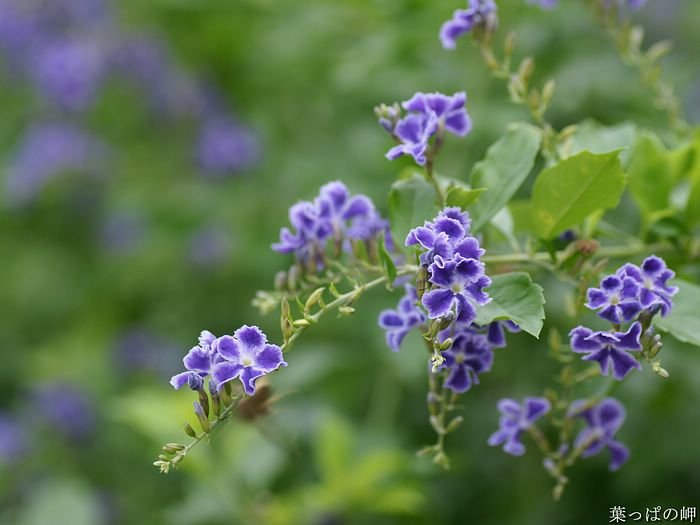

Duranta is registered as an invasive weed by many councils of Australia. It is a prolific, fast growing weed that is spread by birds from domestic areas to natural reserves. It was introduced and marketed as a hedge plant some years ago. Many people now fight to keep this thorny pest under control. It is highly ranked in the most invasive weeds in Australia.
Duranta erecta is a species of flowering shrub in the verbena family Verbenaceae, native from Mexico to South America and the Caribbean. It is widely cultivated as an ornamental plant in tropical and subtropical gardens throughout the world, and has become naturalized in many places. It is considered an invasive species in Australia, China, South Africa and on several Pacific Islands. Common names include golden dewdrop, pigeon berry, and skyflower. In Mexico, the native Nahuatl name for the plant is xcambocoché. In Tonga it is known as mavaetangi (tears of departure).
Scientific classification e
Kingdom: Plantae
Clade: Angiosperms
Clade: Eudicots
Clade: Asterids
Order: Lamiales
Family: Verbenaceae
Genus: Duranta
Species: D. er
A tropical powerhouse, the golden dewdrop plant (more commonly known as duranta) is a fast-growing tropical shrub with beautiful blooms and fantastic foliage. With the potential to become quite large where they are hardy (some varieties reaching over 15 feet!), these plants make great, quick-growing, warm-season annuals, and can even act as houseplants. Grown primarily for its bountiful blue blooms, many varieties of duranta also have highly ornamental golden foliage.
Source by :https://www.bhg.com/gardening/plant-dictionary/annual/duranta
Nature is beautiful. It is a perfectly ordered system that makes human life possible. The beauty of nature is unmatched by human inventions and design, no matter how much we advance in our lives.That is why human beings turn to natural solutions when their artificial ways fail. We try to make our buildings and our spaces beautiful, but we forget to incorporate nature into them. And when we realize that our indoor spaces have become bland and boring, all we can do is introduce some natural elements to brighten them up again.This is where plants come in. These are a symbol of natural beauty and elegance that we humans can only marvel at. Many people love to grow plants inside their homes, and one of the primary intentions while doing so is to add color in the home. While there are many plants that can be grown indoors to add color and life, the Duranta plant is one of the most attractive.
Duranta plants prefer sunny environments. They like plenty of light to grow to their full potential. If placed outside, they should be placed in the full sun. The plant can be grown in partial sun as well as in dry areas. This, however, causes its growth to be affected in a negative way.When placed inside, you can keep it in front of a south-facing window that lets in plenty of light. Placing it in front of a south-east or south-west window without curtains would work better in case you want to control the height from getting too much for an indoor space.
Context Source: http://www.metropolitanwholesale.com/duranta-plant-care/
Duranta is a sprawling, sometimes vinelike tender evergreen shrub or small tree that can get up to 18 ft (5.5 m) tall and just as wide. It usually forms a multi-stemmed clump with branches that droop and trail. Some bushes are quite spiny, and some have no spines at all. The showy flowers bloom almost all year long in terminal or lateral clusters (racemes, actually) up to 6 in (15.2 cm) long.
Features
This is a very showy shrub with pretty blue flowers that attract butterflies and bright golden berries that are relished by songbirds both often present on the plant at the same time. It is recommended as a nectar plant in subtropical butterfly gardens. Individual plants may sprawl, but it is not invasive.
Warning
The attractive fruits are poisonous to humans. Do not use this shrub in childrens' play areas.
Source of Info
this duranta plants very attractive.i like gardening.because its my hobby🌴🌾............
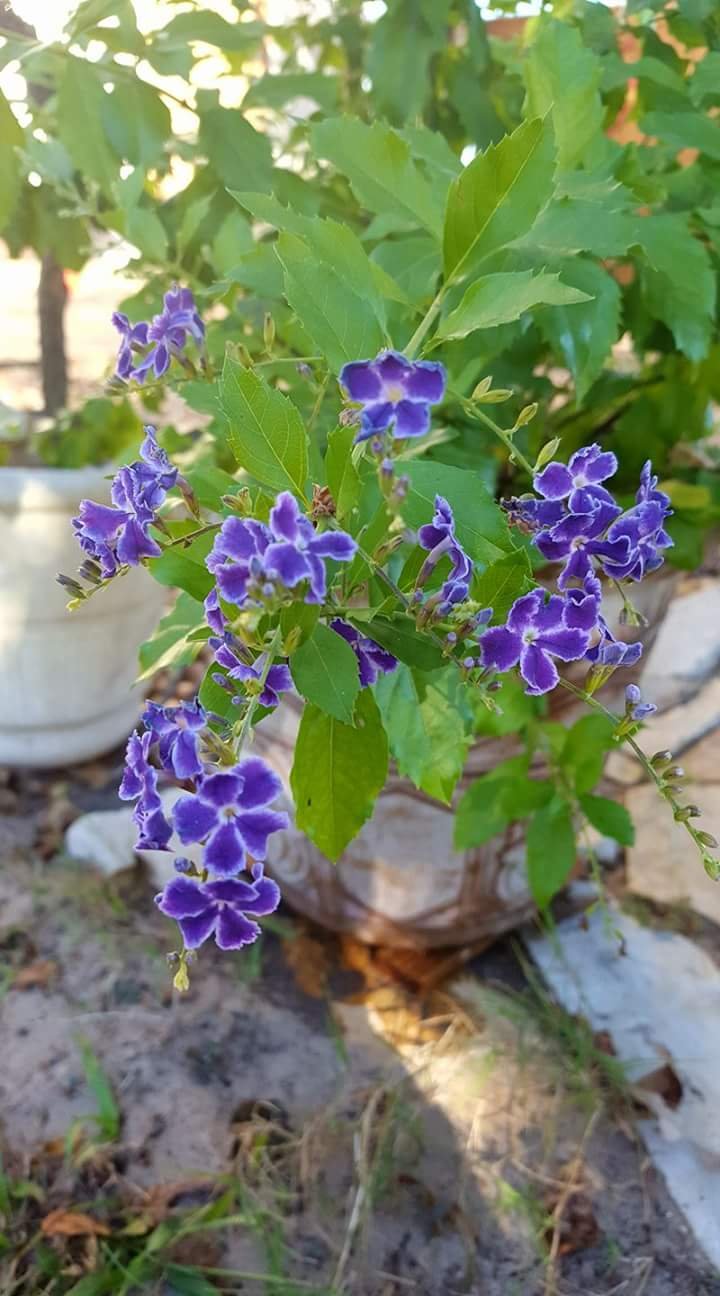
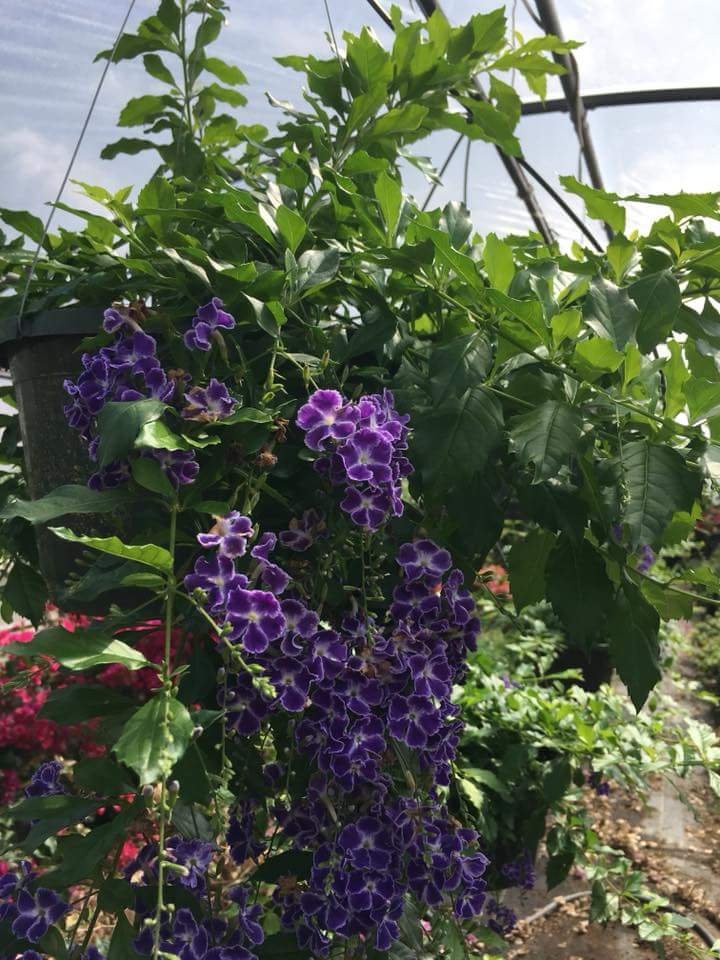
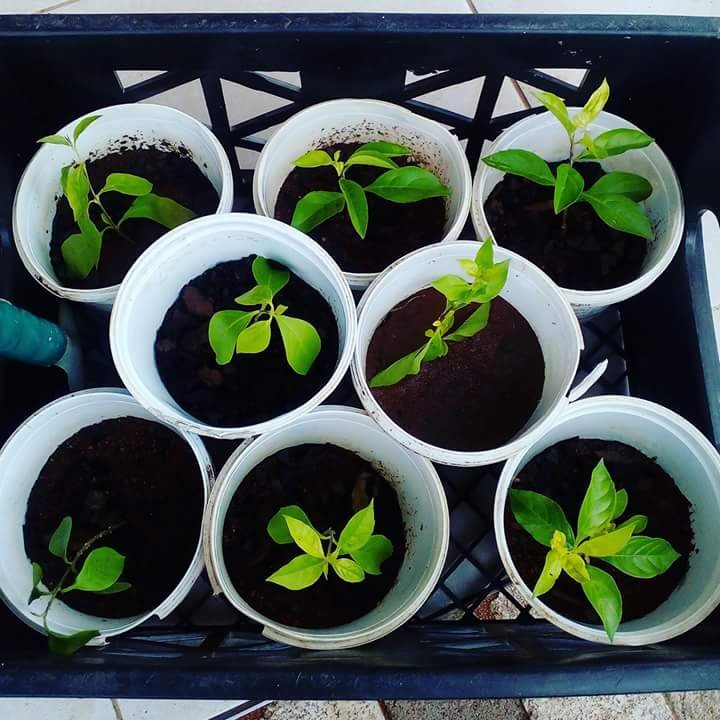 description:- Duranta erecta
description:- Duranta erecta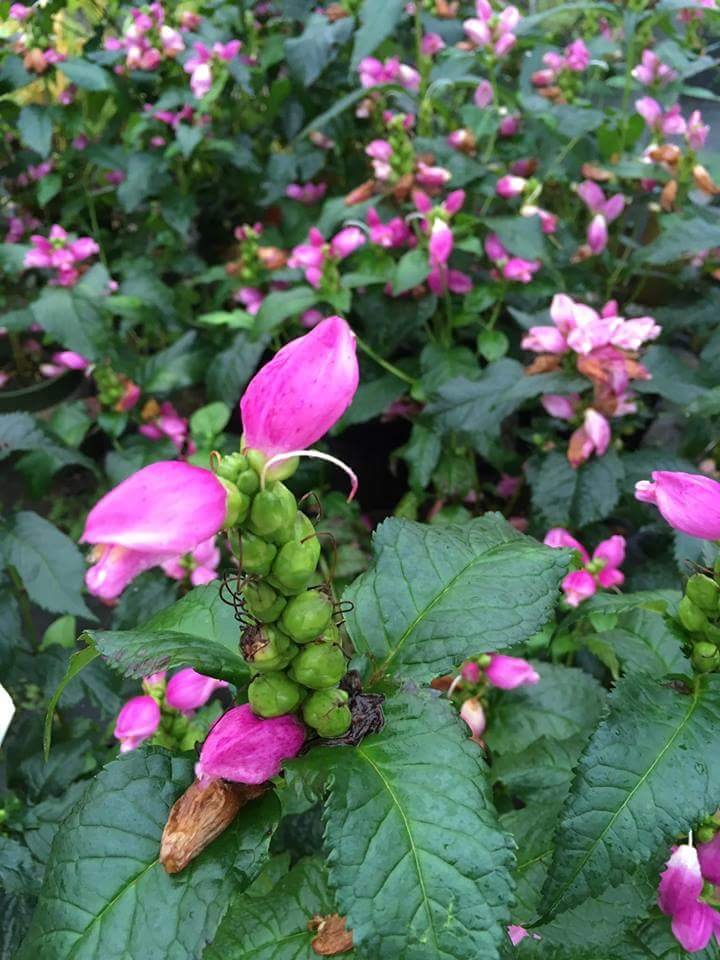 cultivation:-Golden dewdrop is widely grown as an ornamental plant throughout tropical and warm subtropical regions. [4] Its showy flowers and fruit make it a desirable addition to gardens, and the blossoms attract butterflies and hummingbirds . [4] There are a wide variety of
cultivation:-Golden dewdrop is widely grown as an ornamental plant throughout tropical and warm subtropical regions. [4] Its showy flowers and fruit make it a desirable addition to gardens, and the blossoms attract butterflies and hummingbirds . [4] There are a wide variety of 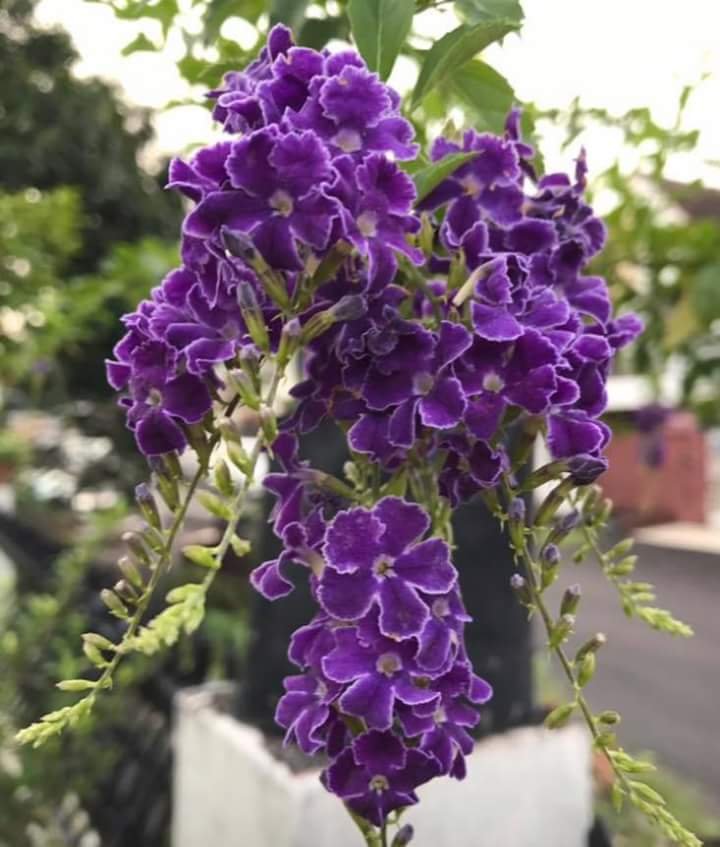 cultivars available, including 'alba', 'aurea', 'Aussie gold', 'gold mound', 'geisha girl', 'sapphire showers', and 'variegata'. thanks to sharing for your good post dear....friend.. @ctrl-alt-nwo
cultivars available, including 'alba', 'aurea', 'Aussie gold', 'gold mound', 'geisha girl', 'sapphire showers', and 'variegata'. thanks to sharing for your good post dear....friend.. @ctrl-alt-nwo
.....🌹🌹...............!.......!
Duranta erecta is a species of flowering shrub in the verbena family Verbenaceae, native from Mexico to South America and the Caribbean. It is widely cultivated as an ornamental plant in tropical and subtropical gardens throughout the world, ...
Family Name : Verbenaceae. Synonyms : Duranta plumiera, Duranta repens. Common Names : Golden Dew-Drop, Lilac-flowered Golden Dewdrop, Pigeon Berry, Sky Flower, Brazilian Sky Flower, Kachang Puteh, Forget-Me-Not.
Duranta erecta is a sprawling shrub or (infrequently) a small tree . It can grow to 6 m (20 ft) tall and can spread to an equal width. Mature specimens possess axillary thorns , which are often absent on younger specimens. The leaves are light green, elliptic to ovate, opposite, and grow up to 7.5 cm (3.0 in) long and 3.5 cm (1.4 in) broad, with a 1.5 cm petiole. The flowers are light-blue or lavender, produced in tight clusters located on terminal and axillary stems, blooming almost all year long. The fruit is a small globose yellow or orange berry , up to 11 mm (0.43 in) diameter and containing several seeds . [2] The leaves and berries of the plant are toxic , and are confirmed to have killed children, dogs and
cats . [3] However, songbirds eat the fruit without ill effects.
Duranta erecta is a species of flowering shrub in the verbena family Verbenaceae, native from Mexico to South America and the Caribbean. It is widely cultivated as an ornamental plant in tropical and subtropical gardens throughout the world, and has become naturalized in many places. It is considered an invasive species in Australia, China, South Africa and on several Pacific Islands. Common names include golden dewdrop, pigeon berry, and skyflower. In Mexico, the native Nahuatl name for the plant is xcambocoché. In Tonga it is known as mavaetangi (tears of departure).

Duranta is registered as an invasive weed by many councils of Australia. It is a prolific, fast growing weed that is spread by birds from domestic areas to natural reserves. It was introduced and marketed as a hedge plant some years ago. Many people now fight to keep this thorny pest under control. It is highly ranked in the most invasive weeds in Australia.



Duranta erecta is a sprawling shrub or (infrequently) a small tree. It can grow to 6 m (20 ft) tall and can spread to an equal width. Mature specimens possess axillary thorns, which are often absent on younger specimens. The leaves are light green, elliptic to ovate, opposite, and grow up to 7.5 cm (3.0 in) long and 3.5 cm (1.4 in) broad, with a 1.5 cm petiole. The flowers are light-blue or lavender, produced in tight clusters located on terminal and axillary stems, blooming almost all year long. The fruit is a small globose yellow or orange berry, up to 11 mm (0.43 in) diameter and containing several seeds. The leaves and berries of the plant are toxic, and are confirmed to have killed children, dogs and cats. However, songbirds eat the fruit without ill effects
Duranta erecta is native to the Americas, from Mexico and the Caribbean south to Brazil and Argentina. There is some debate about whether the plant is also native to the southern United States, in Florida, Louisiana, Texas, Arizona and California, or is an introduced species there. In its natural state, it commonly grows in rocky or sandy coastal areas with full sun, or moister, disturbed sites inland. Prior to maturity, the plant will grow at a rate of up to half a meter per year.
If you can grow Esperanza Tecoma stans and Plumbago, you can grow Duranta.erecta as a tall summer annual or shrubby perennial depending upon the severity of winter temperatures and as an annual in zones cooler than zone 8b.
In 2011 I took cuttings to keep through the winter.
Making a note to do that again next fall.
I made a conscious decision to keep white and red begonias this winter, not pink.
.jpg)
magoo-2 found a series of multi accounts of a same owner is following your articles to cheat your generous rewards.
magoo-2 found these accounts are suspicious & can be multi accounts of a single owner. Conclusion is based on last 30 days transactions:
@anik1998
@anikearn
@anikhassan007
@anik-hassan
@fazlehassan
@kinggo
@shuvrokhan
@rahuljoy
@sohelkhan007
@rockykhan
@alex-linda
@sportslover
@shanto62
@nodald-pump
@shikto
@fariha1752
@yanafariha
magoo-2
Check our latest multi comment spam update report
I only have 1 account.
Later on, I will take action for you
Hello dear friend @ctrl-alt-nwo. I hope you you're doing good. Here is my research on this flower please have a look
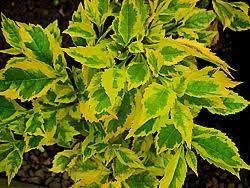
The Duranta flowering plant (Duranta erecta) may reach up to 10 feet in height and flowers profusely from summer until the first heavy frost. The shrub-like plant is multi-stemmed and the branches are somewhat droopy. The stems may have sharp spines. Orchid-like flowers may be light blue to light purple in color. Some plants develop loads of yellow, ball-shaped drupes. Chemicals in the fruit may make them poisonous to humans but harmless to birds that enjoy them immensely.
Source
I Hope you will consider my effort @ctrl-alt-nwo
These tender flowering shrubs feature glossy green leaves arranged in pairs or whorls along stems. Attractive blue or white flowers in clusters attract butterflies in summer, are followed by bunches of berrylike yellow fruit. Plants marketed as Duranta stenostachya are often actually Duranta erecta; distinguishing characteristics are described below. Use as quick, tall screen. Thrive in heat. Need continual thinning and pruning to stay under control. Good container plants.
The Duranta bush grows as an evergreen, rounded shrub or small tree in U.S. Department of Agriculture plant hardiness zones 9b through 11a. In colder climates, gardeners plant it as an annual in the garden or in containers. The Duranta bush grows quickly up to 15 feet high and wide as a shrub, but it tops out at about 5 feet tall when planted as an annual.
Flowers and Foliage

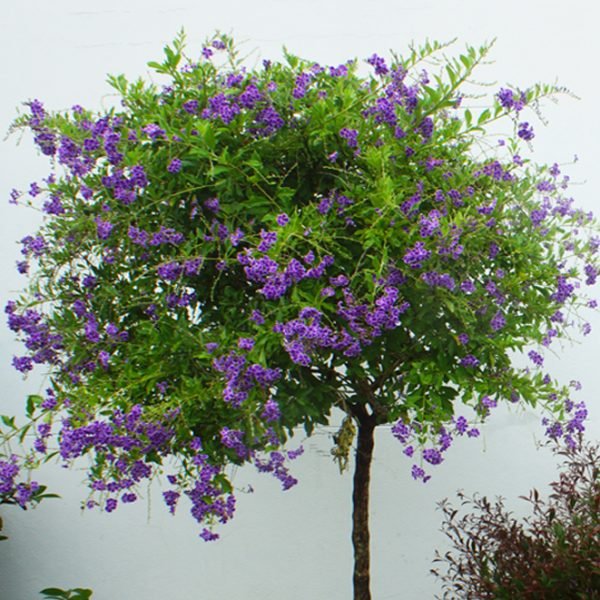
The Duranta bush’s fragrant lavender, purple or white flowers attract butterflies and hummingbirds to your landscape. The small flowers dangle from thorny, weeping branches with light gray bark among glossy, green, oval-shaped leaves. The blossoms turn into small, yellow, berry-like fruit called drupes. For eye-catching variegated leaves, select the cultivars “Golden Edge” or “Variegata.”
The ideal spot for a Duranta bush is a moist place with full sun. This shrub attains its optimum size in any kind of well-drained soil with an acidic, neutral or slightly alkaline pH, as long as it’s rich in organic matter. It has an adaptable nature and will also grow in partial sun, as well as dry, rocky or sandy areas, but it won’t reach its full size. The Duranta bush tolerates light to moderate sea spray in coastal zones with dry weather
I collect some data from internet about duranta.. here those...
Duranta Flowering Plant Info :
The Duranta flowering plant (Duranta erecta) may reach up to 10 feet in height and flowers profusely from summer until the first heavy frost. The shrub-like plant is multi-stemmed and the branches are somewhat droopy. The stems may have sharp spines. Orchid-like flowers may be light blue to light purple in color. Some plants develop loads of yellow, ball-shaped drupes. Chemicals in the fruit may make them poisonous to humans but harmless to birds that enjoy them immensely.
Duranta Care Must-Knows
Duranta is an extremely easy-to-grow shrub or annual, depending on your location. These plants thrive in well-drained, moist, fertile soils. They are also very tolerant of sandy soils. In containers, give these plants a standard, well-drained potting mix, and add some slow-release fertilizer. Full sun is best for these shrubs, as they will have better habit and won't get loose as they would in the shade. Flower production will also be much better in full sun. Keep these plants well-watered. If they start to wilt, they will happily bounce back once watered.
(
How to Grow Duranta
If you live in an area where Duranta plants are treated as annuals, a large container (such as a half whiskey barrel) is a fantastic place to grow the plant. When the weather becomes chilly, you can bring the plant inside and place it near a south-facing window for beautiful color all winter long. Duranta plants prefer rich organic soil that is somewhat loamy and drains well. It is especially important to keep soil light if you are planting in a container. Be sure that your container has plenty of drainage holes. If planting in the ground, choose a location that receives full to part sun for best flowering display. Allow plenty of room for this tropical beauty to spread out.
Description of duranta:Duranta erecta is a sprawling shrub or (infrequently) a small tree. It can grow to 6 m (20 ft) tall and can spread to an equal width. Mature specimens possess axillary thorns, which are often absent on younger specimens. The leaves are light green, elliptic to ovate, opposite, and grow up to 7.5 cm (3.0 in) long and 3.5 cm (1.4 in) broad, with a 1.5 cm petiole. The flowers are light-blue or lavender, produced in tight clusters located on terminal and axillary stems, blooming almost all year long. The fruit is a small globose yellow or orange berry, up to 11 mm (0.43 in) diameter and containing several seeds. The leaves and berries of the plant are toxic, and are confirmed to have killed children, dogs and cats. However, songbirds eat the fruit without ill effects..jpg)
.jpg) .
..jpg)
.jpg) .This plant is also very poisonous.Every body is adviced to keep safe distance from this shrub.That's all from me.All the info is taken from google.
.This plant is also very poisonous.Every body is adviced to keep safe distance from this shrub.That's all from me.All the info is taken from google.
Taxonomy:The genus name is in honor of Castore Durante, a fifteenth-century Italian botanist.[5] The specific epithet erecta means "upright" in Latin. The plant is also known as D. repens, from the Latin for "creeping". The latter name was originally used to identify smaller-leaved varieties of the species.
Ecology:Duranta erecta is native to the Americas, from Mexico and the Caribbean south to Brazil and Argentina. There is some debate about whether the plant is also native to the southern United States, in Florida, Louisiana, Texas, Arizona and California, or is an introduced species there. In its natural state, it commonly grows in rocky or sandy coastal areas with full sun, or moister, disturbed sites inland. Prior to maturity, the plant will grow at a rate of up to half a meter per year.
Cultivation:Golden dewdrop is widely grown as an ornamental plant throughout tropical and warm subtropical regions.[4] Its showy flowers and fruit make it a desirable addition to gardens, and the blossoms attract butterflies and hummingbirds.[4] There are a wide variety of cultivars available, including 'alba', 'aurea', 'Aussie gold', 'gold mound', 'geisha girl', 'sapphire showers', and 'variegata'.
Invasive potential:The plant has been identified as an environmental weed in Australia, South Africa, and China,[9] and is described as invasive in Hawaii, Fiji and French Polynesia.[10] It has been introduced to other habitats but has not become invasive.
These delicate blossoming bushes include lustrous green leaves organized in sets or whorls along stems. Alluring blue or white blossoms in groups draw in butterflies in summer, are trailed by clusters of berrylike yellow natural product. Plants showcased as Duranta stenostachya are frequently really Duranta erecta; recognizing qualities are portrayed beneath. Use as snappy, tall screen. Flourish in warm. Need consistent diminishing and pruning to remain under control. Great compartment plants.
The Duranta hedge develops as an evergreen, adjusted bush or little tree in U.S. Division of Agriculture plant strength zones 9b through 11a. In colder atmospheres, plant specialists plant it as a yearly in the garden or in holders. The Duranta hedge develops rapidly up to 15 feet high and wide as a bush, however it best out at around 5 feet tall when planted as a yearly.
Blooms and Foliage
The Duranta shrubbery's fragrant lavender, purple or white blossoms pull in butterflies and hummingbirds to your scene. The little blossoms dangle from prickly, sobbing branches with light dark bark among polished, green, oval-molded clears out. The blooms transform into little, yellow, berry-like organic product called drupes. For eye-getting variegated leaves, select the cultivars "Brilliant Edge" or "Variegata."
The perfect spot for a Duranta bramble is a wet place with full sun. This bush accomplishes its ideal size in any sort of very much depleted soil with an acidic, unbiased or marginally soluble pH, as long as it's rich in natural issue. It has a versatile nature and will likewise develop in incomplete sun, and additionally dry, rough or sandy territories, however it won't achieve its full size. The Duranta shrubbery endures light to direct ocean splash in beach front zones with dry climate.
Darunta, a tropical powerhouse, the golden dewdrop plant is a fast-growing tropical shrub with beautiful blooms and fantastic foliage.Grown primarily for its bountiful blue blooms, many varieties of duranta also have highly ornamental golden foliage.
With its brilliant blue chains of flowers, duranta is a stand-alone knockout. Each individual five-petaled bloom most commonly comes in a vibrant blue shade, often edged in white. There are also other varieties in lighter shades of violet-blue, and even some in bright white.
Duranta is an extremely easy-to-grow shrub or annual, depending on your location. These plants thrive in well-drained, moist, fertile soils. They are also very tolerant of sandy soils. In containers, give these plants a standard, well-drained potting mix, and add some slow-release fertilizer.
Duranta has an extremely fast growth habit. In many cases, this will necessitate frequent pruning in order to keep plants looking their best. The overall habit of duranta tends to be semi-weeping, but you can keep the plant manicured to rounded shrubs.
Some varieties can also have small thorns on the branches—another good reason to keep them away from paths. Because of the many berries these plants produce, they can become invasive in tropical areas, so check with local authorities if you have any concerns.
Care Of Duranta: How To Grow Duranta Plants
The American tropics are home to over 30 different species of evergreen Duranta plants, member of the Verbena family. In the United States, the Golden Dewdrop species is cultivated. In all areas apart from the USDA plant hardiness zones 8-11, this plant is treated as an annual. Let’s learn more about Duranta propagation and care in the home garden. Duranta Flowering Plant Info The Duranta flowering plant (Duranta erecta) may reach up to 10 feet in height and flowers profusely from summer until the first heavy frost. The shrub-like plant is multi-stemmed and the branches are somewhat droopy. The stems may have sharp spines. Orchid-like flowers may be light blue to light purple in color. Some plants develop loads of yellow, ball-shaped drupes. Chemicals in the fruit may make them poisonous to humans but harmless to birds that enjoy them immensely.
How to Grow Duranta
If you live in an area where Duranta plants are treated as annuals, a large container (such as a half whiskey barrel) is a fantastic place to grow the plant. When the weather becomes chilly, you can bring the plant inside and place it near a south-facing window for beautiful color all winter long. Duranta plants prefer rich organic soil that is somewhat loamy and drains well. It is especially important to keep soil light if you are planting in a container. Be sure that your container has plenty of drainage holes. If planting in the ground, choose a location that receives full to part sun for best flowering display. Allow plenty of room for this.
Care of Duranta Plants Slow -fertilizers help encourage prolific flowering and fruiting. It is important to water frequently while the plant is establishing. Water requirements after establishments are low, watering just enough to keep the soil moist and more during times of drought. Some renewal pruning is necessary to keep a nice shape. Duranta propagation is fairly easy using a piece of the woody limb (hardwood cutting) taken in the summer. Dip the end of 6-inch piece of limb into rooting compound and plant. Roots will establish fairly quickly. Seeds are also available and also seem to do well.
https://www.gardeningknowhow.com/ornamental/flowers/duranta/care-of-duranta-plants.htm
magoo-2 found a series of multi accounts of a same owner is following your articles to cheat your generous rewards.
magoo-2 found these accounts are suspicious & can be multi accounts of a single owner. Conclusion is based on last 30 days transactions:
@rik432
@ratul8940
@rahul72
@taylor10
@villani
@wilson6
@masud90
@purepinag
@sumonsha
@perry1
@max1994
magoo-2
Check our latest multi comment spam update report
Duranta is one of my favorite plants with strong blue to purple colours. We also have the ones with white flowers. I notice that butterflies really like to stop by these flowers. So, I planted six plants in the garden just for butterflies, small birds and insects. We call duranta “tien-yod’ which means drops from candle or candle-tears! Because the berries look yellow like the colour of candles used in my country!
We hardly use white candles which are normally used in funeral ceremonies.
Cheers.
wow its the Duranta.i love with my heart,,,one of my favourite,, thanks for your share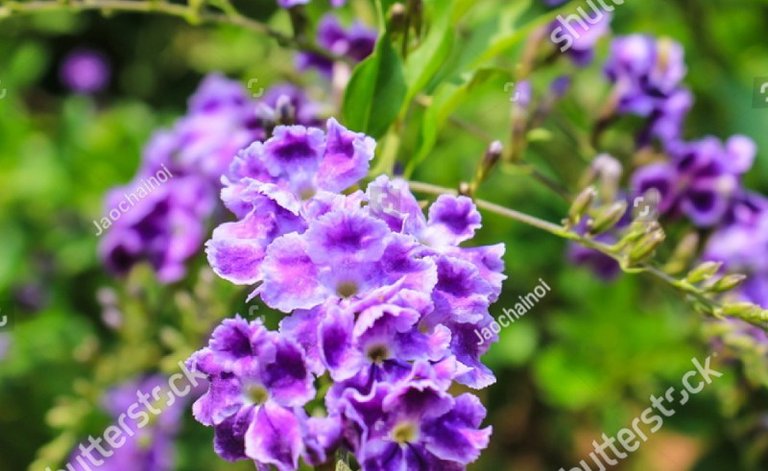
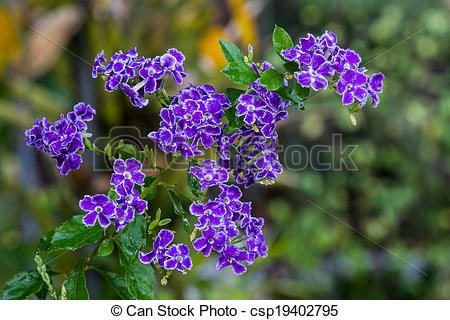
magoo-2 found a series of multi accounts of a same owner is following your articles to cheat your generous rewards.
magoo-2 found these accounts are suspicious & can be multi accounts of a single owner. Conclusion is based on last 30 days transactions:
@rahmanmdriad
@mdriadrahman26
@masterlegend
magoo-2
Check our latest multi comment spam update report
wow,,,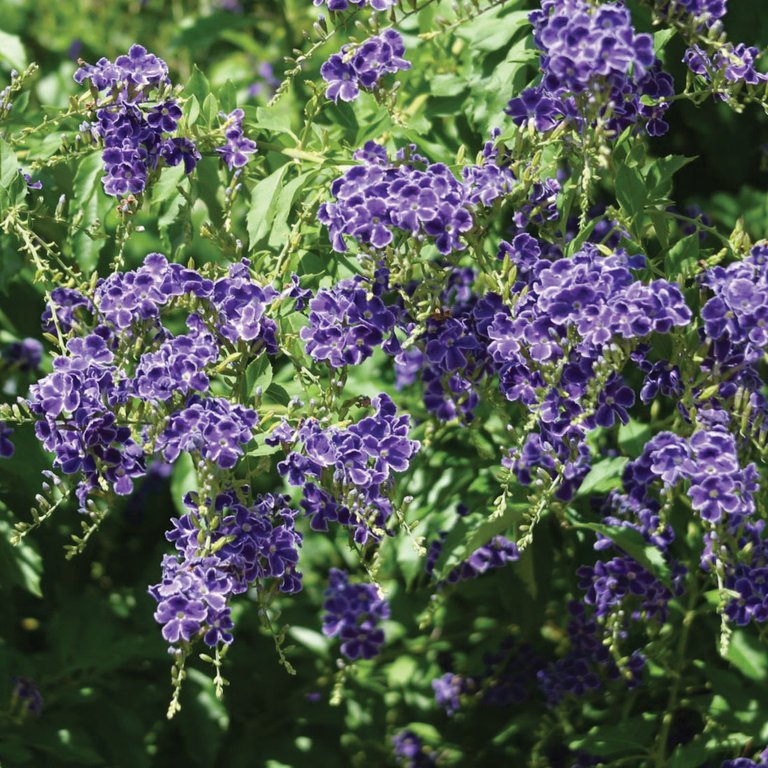
its looking so gorgeous ,,,of
dear friend @ctrl-alt-nwo
thanks for your post,,,
magoo-2 found a series of multi accounts of a same owner is following your articles to cheat your generous rewards.
magoo-2 found these accounts are suspicious & can be multi accounts of a single owner. Conclusion is based on last 30 days transactions:
@rahmanmdriad
@mdriadrahman26
@masterlegend
magoo-2
Check our latest multi comment spam update report
@mdriadrahman26
@masterlegend
these are not my id,,,who vote me ,,and i gave him back,,thats all
Duranta is a nice plant , I don't know what's it called in india . But it's nice plant and it's blue flowers looking awesome .
The color is a very very rich purple color and looking pretty awesome and for the first time I got to know the name of this plant.
So thank you and wishing you a great day.